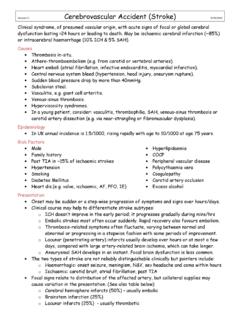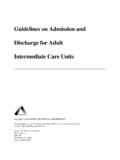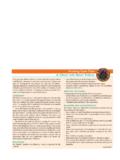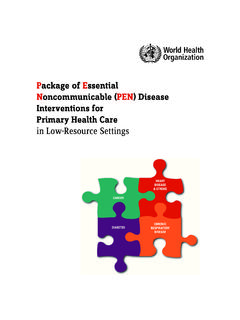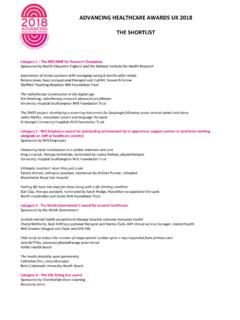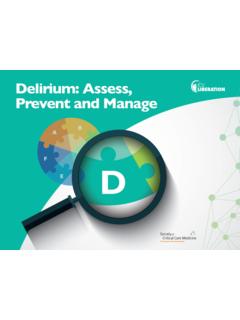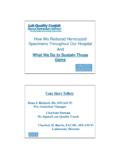Transcription of Table 4.2: Canadian Stroke Best Practices Swallow ...
1 Canadian Best Practice Recommendations for Stroke care Section 4: Acute Inpatient Stroke care Update 2012 - 2013 Recommendations Fourth Edition ~ FINAL Update: May 21st, 2013 Page 30 of 40 Table : Canadian Stroke Best Practices Swallow Screening and Assessment Tools Author/Name of test Components of test Details of validation study Results of original validation study Daniels et al. 1997 1 Any Two Items included: 6 clinical features-dysphonia, dysarthria, abnormal volitional cough (includes water-swallowing test), abnormal gag reflex, cough after Swallow and voice change after Swallow were assessed.
2 Scoring: Presence of any 2 of the items distinguished patients with/without dysphagia Sample: 59 acute Stroke survivors were studied within 5 days of hospital admission. Diagnostic standard: VMBS exam Prevalence of dysphagia: The sensitivities and specificities of individual items ranged from 31% and 61%-88%, respectively. Overall: Sensitivity: 92% Specificity: 67% Logemann et al. 1999 2 28 items divided into 5 categories: i) 4 medical history variables ii) 6 behavioural variables iii) 2 gross motor variables iv) 9 observations from oromotor testing v) 7 observations during trial swallows Scoring: logistic regression was used to identify best single predictors and best combination of predictors.
3 The tool was designed to identify the presence or absence of aspiration, oral stage disorder, pharyngeal delay, and pharyngeal stage disorder. Sample: 202 consecutive patients (34% Stroke ) referred by their physicians for possible dysphagia. Diagnostic standard: VMBS exam Prevalence of dysphagia: Aspiration: Throat clearing, reduced laryngeal elevation and a history of recurrent pneumonia were the best combination of predictors. Sensitivity: 69% Specificity: 73% Pharyngeal stage Swallow disorder: reduced laryngeal elevation was the best single predictor. Sensitivity: 72% Specificity: 67% Perry 2001 3 Standardized Swallowing Assessment 7 items in 2 sections plus water swallowing test Section 1: 2 items to ensure the patient is physically capable of taking the test.
4 Section 2: 5 items comprising a checklist Scoring: if answers to any question is no, then patient fails the screen, otherwise, proceed to water Swallow test (3 trials of 1 teaspoon with progression to cup). If any sign of problems (coughing, choking, change in voice quality), then patient fails. Sample: 200 consecutive admissions of acute Stroke . Diagnostic Standard: Clinical judgement of SLP Prevalence of dysphagia: 47% Sensitivity: 97% Specificity: 90% Trapl et al. 2007 4 Preliminary Assessment (vigilance, throat clearing, saliva Swallow ) Diagnostic standard: fiberoptic endoscopic evaluation using the Canadian Best Practice Recommendations for Stroke care Section 4: Acute Inpatient Stroke care Update 2012 - 2013 Recommendations Fourth Edition ~ FINAL Update: May 21st, 2013 Page 31 of 40 Author/Name of test Components of test Details of validation study Results of original validation study The Gugging Swallowing Screen (GUSS) Direct Swallow ( semisolid, liquid, solid Swallow trials) Scoring.
5 Total scores ranged from 0 (worst) - 20 (no dysphagia). A cut-off score of 14 was selected Sample: 50 first-ever acute Stroke patients with suspected dysphagia Penetration Aspiration Scale to interpret the results. Prevalence of dysphagia: 73% First group of 19 patients using the GUSS to identify subjects at risk of aspiration: Sensitivity: 100%, Specificity: 50% Second group of 30 patients Sensitivity: 100% Specificity: 69% Interrater reliability: Kappa= Martino et al. 2009 5 The Toronto Bedside Swallowing Screening Test (TOR-BSST) Items included: presence of dysphonia before/after water swallowing test, impaired pharyngeal sensation and abnormal tongue movement.
6 Scoring: pass=4/4 items; fail 1/4 items Sample: 311 Stroke patients (103 acute, 208 rehabilitation) Diagnostic standard: VMBS exam. Prevalence of dysphagia: 39% Sensitivity: 91% Specificity: 67% Interrater reliability (based on observations from 50 subjects) ICC = (95% CI: ) Edmiaston et al. 2009 USA 6 Acute Stroke Dysphagia Screen Items included: Glasgow Coma Scale score <13, presence of facial, tongue or palatal asymmetry/weakness. If no to all 3 items, then proceed to 3 oz water swallowing test. Scoring: If there is evidence of change in voice quality, cough or change in vocal quality 1 minute after water swallowing test = fail.
7 Sample: 300 acute Stroke patients screened by nurses within 8 to 32 hours following admission. Diagnostic standard: Mann Assessment of Swallowing Ability (MASA), performed by a SPL. Prevalence of dysphagia: 29% Sensitivity (Dysphagia): 91% Specificity: 74% Sensitivity (aspiration risk): 95% Specificity: 68% Interrater reliability: Kappa=94% Turner-Lawrence et al. 2009 7 Emergency Physician Dysphagia Screen The two-tiered bedside tool was developed by SLPs. Tier 1 items included: voice quality, swallowing complaints, facial asymmetry, and aphasia. Tier 2 items included a water Swallow test, with evaluation for swallowing difficulty, voice quality compromise, and pulse oximetry desaturation ( 2%).
8 Patients failing tier 1 did not move forward to tier 2. Scoring: Patients who passed both tiers were considered to be low-risk. Sample: a convenience sample of 84 Stroke patients (ischemic/hemorrhagic) screened by 45 ER MDs. Diagnostic standard: formal assessment conducted by an SLP Prevalence of dysphagia: 57% Sensitivity: 96% Specificity: 56% Interrater reliability: Kappa= Canadian Best Practice Recommendations for Stroke care Section 4: Acute Inpatient Stroke care Update 2012 - 2013 Recommendations Fourth Edition ~ FINAL Update: May 21st, 2013 Page 32 of 40 Author/Name of test Components of test Details of validation study Results of original validation study Antonios et al.
9 2010 8 Modified Mann Assessment of Swallowing Ability (MMASA) 12 of the 24 MASA items were retained including: alertness, co-operation, respiration, expressive dysphasia, auditory comprehension, dysarthria, saliva, tongue movement, tongue strength, gag, volitional cough and palate movement. Scoring: Maximum score is 100 (no dysphagia). A cut-off score of 94 was used to identify patients at risk of dysphagia Sample: 150 consecutive patients with acute ischemic Stroke were assessed by 2 neurologists shortly after admission to hospital. Diagnostic standard: MASA conducted by SLP Prevalence of dysphagia: Sensitivity: 87% & 93% Specificity: 86% & 84% Interrater reliability: Kappa= Schrock et al.
10 20119 MetroHealth Dysphagia Screen 5 Items included: Alert and able to sit upright for 10 minutes, weak, wet or abnormal voice, drooling, slurred speech and weak, or inaudible cough. Scoring: 1 items answered yes=failed screen Sample: 283 patients admitted to the Emergency department with acute Stroke and screened for the presence of dysphagia by nurses Diagnostic standard: VMBS Prevalence of dysphagia at 30 days: 32% Sensitivity: 95% Specificity: 55% Interrater reliability: Kappa= Reference List 1. Daniels SK, McAdam C, Brailey K, et al. Clinical assessment of swallowing and prediction of dysphagia severity.

